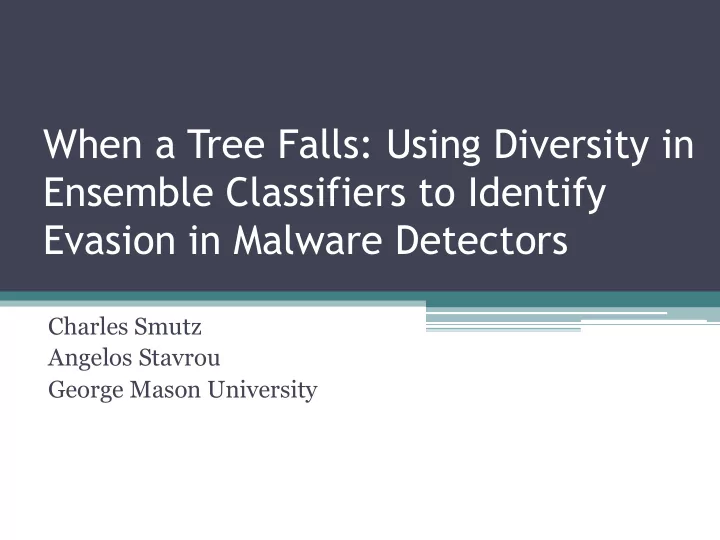

When a Tree Falls: Using Diversity in Ensemble Classifiers to Identify Evasion in Malware Detectors Charles Smutz Angelos Stavrou George Mason University
Motivation • Machine learning used ubiquitously to improve information security ▫ SPAM ▫ Malware: PEs, PDFs, Android applications, etc ▫ Account misuse, fraud • Many studies have shown that machine learning based systems are vulnerable to evasion attacks ▫ Serious doubt about reliability of machine learning in adversarial environments
Problem • If new observations differ greatly from training set, classifier is forced to extrapolate • Classifiers often rely on features that can be mimicked ▫ Features coincidental to malware ▫ Many types of malware/misuse ▫ Feature extractor abuse • Proactively addressing all possible mimicry approaches not feasible
Approach • Detect when classifiers provide poor predictions ▫ Including evasion attacks • Relies on diversity in ensemble classifiers
Background • PDFrate: PDF malware detector using structural and metadata features, Random Forest classifier ▫ pdfrate.com: scan with multiple classifiers Contagio: 10k sample publicly known set University: 100k sample training set • PDFrate evasion attacks ▫ Mimicus: Comprehensive mimicry of features (F), classifier (C), and training set (T) using replica ▫ Reverse Mimicry: Scenarios that hide malicious footprint: PDFembed, EXEembed, JSinject • Drebin: Andriod application malware detector using values from manifest and disassembly
Mutual Agreement Analysis • When ensemble voting disagrees, prediction is unreliable • High level of agreement on most observations Uncertain Malicious Malicious Benign Benign 0% 0% 100% Ensemble 100% Ensemble Vote Score Vote Score
Mutual Agreement A = | v – 0.5 | * 2 v: ensemble vote ratio A: Mutual Agreement • Ratio between 0 and 1 (or 0% and 100%) • Proxy for Confidence on individual observations • Threshold is tunable, 50% used in evaluations
Mutual Agreement • Disagreement caused by extrapolation noise
Mutual Agreement Operation • Mutual agreement trivially calculated at classification time • Identifies unreliable predictions ▫ Identifies detector subversion as it occurs • Uncertain observations require distinct, potentially more expensive detection mechanism • Separates weak mimicry from strong mimicry attacks
Evaluation • Degree to which mutual agreement analysis allows separation of correct predictions from misclassification, including mimicry attacks ▫ PDFrate Operational Data ▫ PDFrate Evasion: Mimicus and Reverse Mimicry ▫ Drebin Novel Android Malware Families • Gradient Descent Attacks and Evasion Resistant Support Vector Machine Ensemble
Operational Data • 100,000 PDFs (243 malicious) scanned by network sensor (web and email) Benign Malicious
Operational Data
Operational Localization (Retraining) • Update training set with portions of 10,000 documents taken from same operational source
Mimicus Results
F_mimicry FT_mimicry FC_mimicry FTC_mimicry
Mimicus Results
Reverse Mimicry Results
JSinject EXEembed PDFembed
Reverse Mimicry Results
Drebin Android Malware Detector • Modified from original linear SVM to use Random Forests Benign Malicious
Drebin Unknown Family Detection • Malware Unknown Family A samples labeled by family • Each family withheld from training set, included in evaluation
Drebin Classifier Comparison
Mimicus GD-KDE Attacks • Gradient Decent and Kernel Density Estimation ▫ Exploits known decision boundary of SVM • Extremely effective against SVM based replica of PDFrate ▫ Average score of 8.9% • Classifier score spectrum is not enough
Evasion Resistant SVM Ensemble • Construct Ensemble of multiple SVM • Bagging of training data ▫ Does not improve evasion resistance • Feature Bagging (random sampling of features) ▫ Critical for evasion resistance • Ensemble SVM not susceptible to GD-KDE attacks
Conclusions • Mutual agreement provides per observation confidence estimate • no additional computation • Feature bagging is critical to creating diversity required for mutual agreement analysis • Strong (and private) training set improves evasion resistance • Operators can detect most classifier failures ▫ Perform complimentary detection, update classifier • Mutual agreement analysis raises bar for mimicry attacks
Charles Smutz, Angelos Stavrou csmutz@gmu.edu, astavrou@gmu.edu http://pdfrate.com
EvadeML Results
Contagio All University All University Best Contagio Best
EvadeML Results
Mutual Agreement Threshold Tuning
Recommend
More recommend